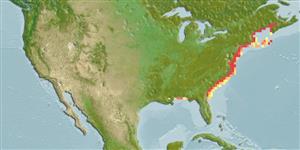Common names from other countries
Environment: milieu / climate zone / depth range / distribution range
Ecologia
; intervalo de profundidade 0 - 36 m (Ref. 83435). Subtropical, preferred 17°C (Ref. 107945); 49°N - 30°N, 80°E - 65°W (Ref. 83435)
Atlantic and the Mediterranean.
Length at first maturity / Tamanho / Peso / Idade
Maturity: Lm ? range ? - ? cm Max length : 13.0 cm TL macho/indeterminado; (Ref. 7726); Idade máx. registada: 9 anos (Ref. 2823)
Maximum depth from Ref. 104365. Found buried in muddy sediment on the lower shore and shallow sublittoral and in bays and estuaries. Prefers sandy environments to depths of 15 m (Ref. 78574).
Life cycle and mating behavior
Maturidade | Reprodução | Desova | Ovos | Fecundidade | Larvas
Members of the class Bivalvia are mostly gonochoric, some are protandric hermaphrodites. Life cycle: Embryos develop into free-swimming trocophore larvae, succeeded by the bivalve veliger, resembling a miniature clam.
Harvey-Clark, C. 1997. (Ref. 7726)
Status na Lista Vermelha da IUCN (Ref. 130435)
Status no CITES (Ref. 108899)
Not Evaluated
Not Evaluated
Uso pelos humanos
Pescarias: espécies comerciais
FAO - Aquacultura: produção, perfil da espécie; pescarias: landings, perfil da espécie | FishSource | Sea Around Us
Ferramentas
Fontes da internet
Estimates based on models
Preferred temperature
(Ref.
115969): 8.8 - 23.7, mean 13.2 (based on 120 cells).
Resiliência
Elevada, tempo mínimo de duplicação da população menor que 15 meses (K=0.16-0.5; tmax=9).
Prior r = 0.43, 95% CL = 0.28 - 0.65, Based on 3 data-limited stock assessments.
Vulnerabilidade
Low to moderate vulnerability (25 of 100).
